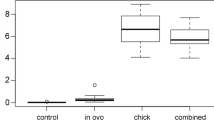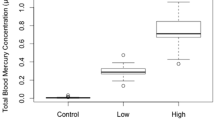Abstract
To determine the level of in ovo methylmercury (MeHg) exposure that results in detrimental effects on fitness and survival of loon embryos and hatched chicks, we conducted a field study in which we injected eggs with various doses of MeHg on day 4 of incubation. Eggs were collected following about 23 days of natural incubation and artificially incubated to observe hatching. Reduced embryo survival was evident in eggs injected at a rate of ≥1.3 μg Hg/g wet-mass. When maternally deposited Hg and injected Hg were considered together, the median lethal concentration of Hg (LC50) was estimated to be 1.78 μg Hg/g wet-mass. Organ mass patterns from eggs of chicks injected at a rate of 2.9 μg Hg/g differed from that of controls and chicks from the 0.5 μg Hg/g treatment, largely related to a negative relation between yolk sac mass and egg mercury concentration. Chicks from eggs in the 2.9 μg Hg/g treatment were also less responsive to a frightening stimulus than controls and chicks from the 0.5 μg Hg/g treatment. We also found that the length of incubation period increased with increasing egg mercury concentration. Tissue Hg concentrations were strongly associated (r 2 ≥ 0.80) with egg Hg concentration.



Similar content being viewed by others
References
Abbott WS (1925) A method of computing the effectiveness of an insecticide. J Econ Entomol 18:265–267
Ackerman JT, Eagles-Smith CA (2009) Integrating toxicity risk in bird eggs and chicks: using chick down feathers to estimate mercury concentrations in eggs. Environ Sci Technol 43:2166–2172
Anderson MJ, Gorley RN, Clarke KR (2008) PERMANOVA+ for PRIMER: guide to software and statistical methods. PRIMER-E, Plymouth
Barr JF (1986) Population dynamics of the common loon (Gavia immer) associated with mercury-contaminated waters in north-western Ontario. Occasional Paper No. 56. Canadian Wildlife Service, Ottawa
Bennett RS, French JB Jr, Rossmann R, Haebler R (2009) Dietary toxicity and tissue accumulation of methylmercury in American kestrels. Arch Environ Contam Toxicol 56:149–156
Clarke KR (1999) Nonmetric multivariate analysis in community-level ecotoxicology. Environ Toxicol Chem 18:118–127
Clarke KR, Gorley RN (2006) PRIMER v6: user manual/tutorial. PRIMER-E, Plymouth
Clarke KR, Warwick RM (2001) Change in marine communities: an approach to statistical analysis and interpretation, 2nd edn. PRIMER-E, Plymouth
DeWitt JC, Meyer EB, Henshel DS (2005) Environmental toxicity studies using chickens as surrogates for wildlife: effects of vehicle volume. Arch Environ Contam Toxicol 48:260–269
Evers DC, Taylor KM, Major A, Taylor RJ, Poppenga RH, Scheuhammer AM (2003) Common loon eggs as indicators of methylmercury availability in North America. Ecotoxicology 12:69–81
Evers DC, Savoy LJ, DeSorbo CR, Yates DE, Hanson W, Taylor KM, Siegel LS, Cooley JH Jr, Bank MS, Major A, Munney K, Mower BF, Vogel HS, Schoch N, Pokras M, Goodale MW, Fair J (2008) Adverse effects from environmental mercury loads on breeding common loons. Ecotoxicology 17:69–81
Fevold BM, Meyer MW, Rasmussen PW, Temple SA (2003) Bioaccumulation patterns and temporal trends in mercury exposure in Wisconsin common loons. Ecotoxicology 12:83–93
Fimreite N (1971) Effects of dietary methylmercury on ring-necked pheasants. Occasional Paper No. 9. Canadian Wildlife Service, Ottawa
Heinz GH (1974) Effects of low dietary levels of methyl mercury on mallard reproduction. Bull Environ Contam Toxicol 11:386–392
Heinz GH (1975) Effects of methylmercury on approach and avoidance behavior of mallard ducklings. Bull Environ Contam Toxicol 13:554–564
Heinz GH (1979) Methylmercury: reproductive and behavioral effects on three generations of mallard ducks. J Wildl Manag 43:394–401
Heinz GH, Hoffman DJ (1998) Methylmercury chloride and selenomethionine interactions on health and reproduction in mallards. Environ Toxicol Chem 17:139–145
Heinz GH, Hoffman DJ, Konrad SL, Erwin CA (2006) Factors affecting the toxicity of methylmercury injected into eggs. Arch Environ Contam Toxicol 50:264–279
Heinz GH, Hoffman DJ, Klimstra JD, Stebbins KR, Konrad SL, Erwin CA (2009) Species differences in the sensitivity of avian embryos to methylmercury. Arch Environ Contam Toxicol 56:129–138
Hoffman DJ, Moore JM (1979) Teratogenic effects of external egg applications of methyl mercury in the mallard, Anas platyrhynchos. Teratology 20:453–462
Kenow KP, Gutreuter S, Hines RK, Meyer MW, Fournier F, Karasov WH (2003a) Effects of methyl mercury exposure on the growth of juvenile common loons. Ecotoxicology 12:171–182
Kenow KP, Meyer MW, Fournier F, Karasov WH, Elfessi A, Gutreuter S (2003b) Effects of subcutaneous transmitter implants on growth, behavior, energetics, and survival of Common Loon chicks. J Field Ornithol 74:179–186
Kenow KP, Grasman KA, Hines RK, Meyer MW, Gendron-Fitzpatrick A, Spalding MG, Gray BR (2007a) Effects of methylmercury exposure on the immune function of juvenile common loons. Environ Toxicol Chem 26:1460–1469
Kenow KP, Meyer MW, Hines RK, Karasov WH (2007b) Distribution and accumulation of mercury in tissues and organs of captive-reared common loon (Gavia immer) chicks. Environ Toxicol Chem 26:1047–1055
Kenow KP, Hoffman DJ, Hines RK, Meyer MW, Bickham JW, Matson CW, Stebbins KR, Montagna P, Elfessi A (2008) Effects of methylmercury exposure on glutathione metabolism, oxidative stress, and chromosomal damage in captive-reared common loon (Gavia immer) chicks. Environ Pollut 156:732–738
Kenow KP, Hines RK, Meyer MW, Suarez S, Gray BR (2010) Effects of methylmercury exposure on the behavior of captive-reared common loon (Gavia immer) chicks. Ecotoxicology 19:933–944
Kruskal JB (1964) Multidimensional scaling by optimizing goodness of fit to a nonmetric hypothesis. Psychometrika 29:1–27
Kubiak TJ, Harris HJ, Smith LM, Schwartz TR, Stalling DL, Trick JA, Sileo L, Docherty DE, Erdman TC (1989) Microcontaminants and reproductive impairment of the Forster’s tern on Green Bay, Lake Michigan–1983. Arch Environ Contam Toxicol 18:706–727
McNabb FMA (2000) Thyroids. In: Whittow GC (ed) Sturkie’s avian physiology, 5th edn. Academic Press, London
Murk AJ, Boudewijn TJ, Meininger PL, Bosveld ATC, Rossaert G, Ysebaert T, Meire P, Dirksen S (1996) Effects of poyhalogenated aromatic hydrocarbons and related contaminants on common tern reproduction: Integration of biological, biochemical, and chemical data. Arch Environ Contam Toxicol 31:128–140
Nocera JJ, Taylor PD (1998) In situ behavioral response of common loons associated with elevated mercury (Hg) exposure. Conserv Ecol 2:article 10. http://www.consecol.org/vol2/iss2/art10/
Rossmann R (2002) Quality assurance plan: methyl mercury, total mercury, and moisture content in kestrel tissues, blood, eggs, and feces. LLRS-MET-QAP-002, Revision 1, Large Lakes Research Station, United States Environmental Protection Agency
Scheuhammer AM (1991) Effects of acidification on the availability of toxic metals and calcium to wild birds and mammals. Environ Pollut 71:329–375
Scheuhammer AM, Blancher P (1994) Potential risk to common loons (Gavia immer) from methylmercury exposure in acidified lakes. Hydrobiologia 279(280):445–455
Stickel LF, Weimeyer SN, Blus NJ (1973) Pesticide residues in eggs of wild birds: adjustment for loss of moisture and lipids. Bull Environ Contam Toxicol 9:193–196
Tejning S (1967) Biological effects of methyl mercury dicyandiamide-treated grain in the domestic fowl Gallus gallus L. Oikos 8(Suppl):1–116
U. S. Environmental Protection Agency (1997) Mercury study report to Congress, vol 1: Executive Summary. EPA-452/R-97-003, Washington, DC
Wiener JG (1987) Metal contamination of fish in low-pH lakes and potential implications for piscivorous wildlife. Trans N Am Wildl Nat Resour Conf 52:645–657
Wiener JG, Krabbenhoft DP, Heinz GH, Scheuhammer AM (2003) Ecotoxicology of mercury. In: Hoffman DJ, Rattner BA, Burton GA Jr, Cairns J Jr (eds) Handbook of ecotoxicology, 2nd edn. CRC Press, Boca Raton
Acknowledgments
The authors acknowledge the following individuals for their assistance: S. C. Houdek, C. D. Pollentier, T. Daulton, J. Wilson, P. Boma, M. Parrara, M. Stuber assisted with nest monitoring and egg collection; J. Bernardy prepared dose solutions; J. C. Filkins, E. L. Pfeiffer, and B. Raymond conducted laboratory mercury analyses; and Z. Guan provided advice on statistical analyses. G. Heinz, D. Hoffman, and J. Waide provided constructive comments on earlier drafts of this manuscript. Financial and in-kind support for this project was provided by the Wisconsin Department of Natural Resources, the U.S. Environmental Protection Agency, and the U.S. Geological Survey.
Author information
Authors and Affiliations
Corresponding author
Rights and permissions
About this article
Cite this article
Kenow, K.P., Meyer, M.W., Rossmann, R. et al. Effects of injected methylmercury on the hatching of common loon (Gavia immer) eggs. Ecotoxicology 20, 1684–1693 (2011). https://doi.org/10.1007/s10646-011-0743-9
Accepted:
Published:
Issue Date:
DOI: https://doi.org/10.1007/s10646-011-0743-9




